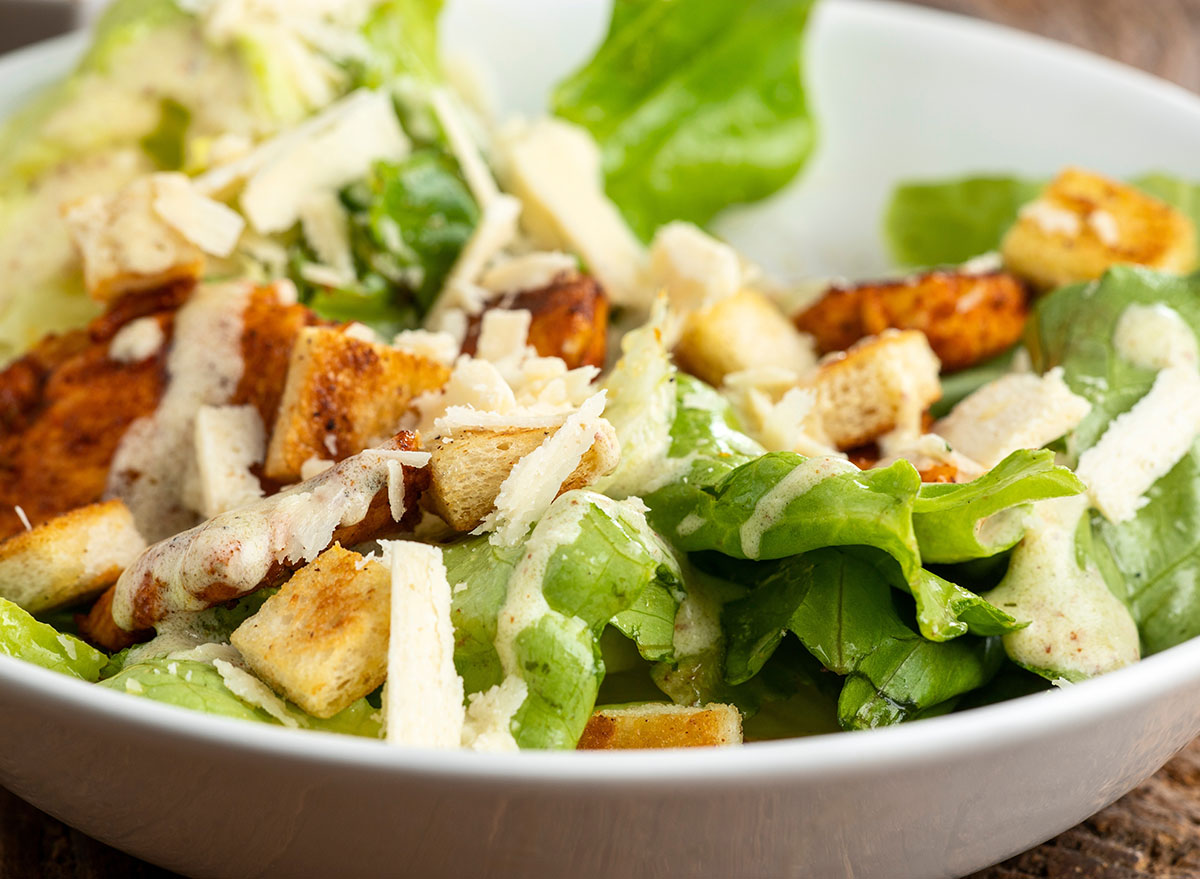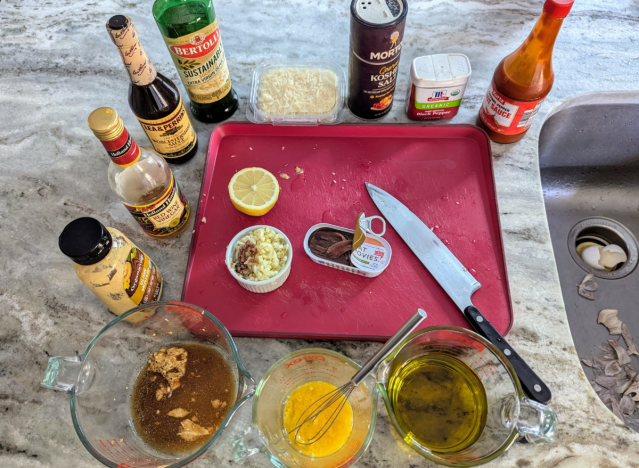How to Make the Best Caesar Salad, According to Chefs

There are few salads more classic and widely beloved than a Caesar salad. Even fewer salads have been popular for an entire century like this creamy mix of lettuce, cheese, and croutons, which reached its 100th anniversary just this summer.
The longstanding steakhouse essential was first created in Tijuana, Mexico, but it's truly "an Italian salad," according to culinary historian Jeffrey Pilcher. "Caesar Cardini, the inventor of the salad, was an Italian immigrant," Pilcher explained during a recent interview with NPR. "And there were many Italian immigrants to Mexico, and they opened up restaurants."
A popular destination for its bullfights, nightclubs, and free-flowing booze during the Prohibition era, Tijuana in 1924 was inundated with California tourists who flocked south of the border to celebrate the Fourth of July. Scrambling to feed the crowds at his restaurant, Caesar's Place, Cardini legendarily tossed together ingredients he had on hand and made a show of it in the dining room.
The rest, as the saying goes, is now history. The city of Tijuana recently commemorated the dish's invention by staging a food and wine festival and erecting a statue of Cardini.
Luckily, the Caesar salad is so ubiquitous now that no one needs to travel very far to find a good iteration. Versions not only pop up in restaurants of nearly every kind, but also on grocery store shelves as salad kits. One brand, Fresh Express, offers as many as 11 different Caesar salad varieties.
That's because the base of any Ceasar salad is refreshingly simple. All you need to call a salad a Caesar is a bed of romaine lettuce, croutons, and Caesar dressing, which typically includes aromatics, Worcestershire sauce, lemon, and some kind of parmesan cheese.
We asked two professional chefs for their advice on making the very best restaurant-quality Caesar salad at home: Ryan Delesandro of Chops Lobster Bar, one of the finest traditional steakhouses in Atlanta, and Brian O'Rourke, executive chef at upscale Ray's on the River, in nearby Sandy Springs, Ga. Here's how to do it:
Gather your tools

Set up your workspace and collect the kitchen tools you need to get going. By taking stock of what tools you need, you save time and frustration tracking everything down as you're trying to work. You'll need these items in this order:
Cheese grater
Liquid measuring cups
Measuring spoons
Sharp chef's knife
Cutting board
Whisk
Salad spinner
Large salad bowl
Salad tongs
Gather your ingredients

Pre-assembling your portioned-out ingredients—otherwise known as mise-en-place—is often considered one of the most critical steps you'll take to set yourself up for success in the kitchen. However, when making Caesar salad from scratch, you can save the step as the order of the majority of the ingredients don't matter and are going in the same bowl.
What you'll need:
1 whole garlic, finely chopped
1 anchovy fillet
1 ¼ tsp Dijon mustard
1 ¼ tsp Worcestershire sauce
1 ½ tbsp lemon juice, freshly squeezed
1 ½ tbsp ice cold water
¼ tsp hot sauce
1 tsp red wine vinegar
2 tbsp beaten whole egg
¼ tsp black pepper
½ tsp salt
1 ¼ cup olive oil
2 tbsp Grana Padano or Parmigiano Reggiano cheese, freshly grated and more for finishing
Three heads of Romaine hearts
Make your croutons (optional)
"Store-bought croutons are fine," Delesandro says. "But they are really easy to make!" If you happen to have a day-old baguette in your kitchen, try your hand at making traditional croutons. "It's as simple as dicing [it] into cubes, tossing with a little olive oil, salt, pepper, and dried oregano, then baking at 300 degrees Fahrenheit for ten minutes, or until crunchy."
O'Rourke goes the crumbles route, which has become popular in chopped salad kits. At Ray's on the River, the Caesar salad is topped with his Bagna Cauda Breadcrumbs. To make these:
1. Blend 1 ½ ounces of minced anchovies and 2 ounces fresh garlic into a paste.
2. Sauté this paste in 2 ounces of unsalted butter.
3. Mix with 1 quart of panko bread crumbs in a bowl with ½ teaspoon each of kosher salt and black pepper.
4. Spread the mixture onto a parchment paper-lined sheet pan and bakes for up to 20 minutes at 350 degrees Fahreneheit, stirring every five minutes.
This yields an entire quart, which you can cool and store in an airtight container for next use.
Make your dressing

It's easy enough to buy premade Caesar dressing, but it's not that much harder to make your own. Plus, this recipe yields enough for plenty of future Caesar salads, and is better chilled, anyway. Just give it a good whisking before using if any separation has occurred.
Additionally, making it yourself gives you freedom to personalize the amount based on personal preference. For instance, O'Rourke often adds more anchovy and blends the dressing for a smoother texture. And for those who don't care for a lot of garlic, it's easy to reduce the amount on this delightfully sharp and garlic-heavy dressing recipe used by Delesandro at Chops.
1. Measure out your olive oil.
2. Finely mince the anchovies and garlic and add to a large mixing bowl.
3. Combine the remaining ingredients up to the salt, omitting only the oil, cheese, and lettuce.
4. Slowly add the oil and whisk it in to emulsify the ingredients.
5. Once emulsified, add the cheese.
For a creamier consistency, O'Rourke uses a blender instead of a whisk at Ray's on the River. Purée the dressing ingredients and slowly add the oil then the cheese directly to the mixture as you blend.
Prepare the lettuce

Plastic lettuce knives have become rather popular, but a good chef's knife will still do the trick. "Use a very sharp knife so you don't bruise your lettuce," O'Rourke advises. Specifically for romaine, he uses the following technique.
1. Quarter the romaine heart lengthwise, leaving the core intact.
2. Cut the quarters into bite sizes, around 1 to 1½ inch pieces. Discard the core.
3. Wash in cold water and spin to dry. This will help the lettuce crisp up.
4. Once dry, place the lettuce in the serving dish, preferably a very large salad bowl.
Assemble your salad

"Ideally, you want just enough dressing to evenly coat your lettuce without overpowering its fresh taste," O'Rourke says. "To achieve nice balance, a good ratio of dressing would be one fluid ounce of dressing for every cup of lettuce."
1. Measure out roughly a cup of salad dressing from your prepared batch. Pour over the lettuce.
2. Using salad tongs, toss the lettuce thoroughly until all bites are coated.
3. Top with croutons (O'Rourke recommends roughly six croutons per two-cup serving) or cover evenly with the seasoned breadcrumb mixture.
4. Finish with freshly grated cheese to taste and, if desired, fresh cracked pepper. Serve immediately.









